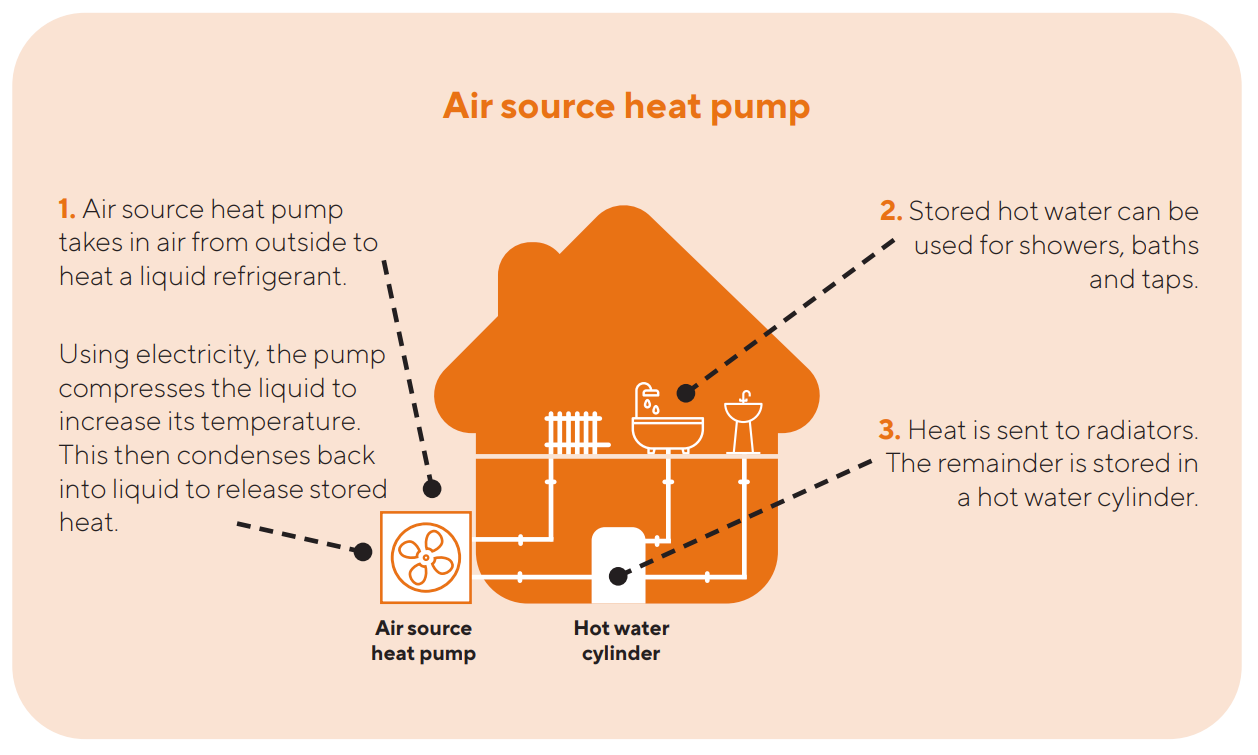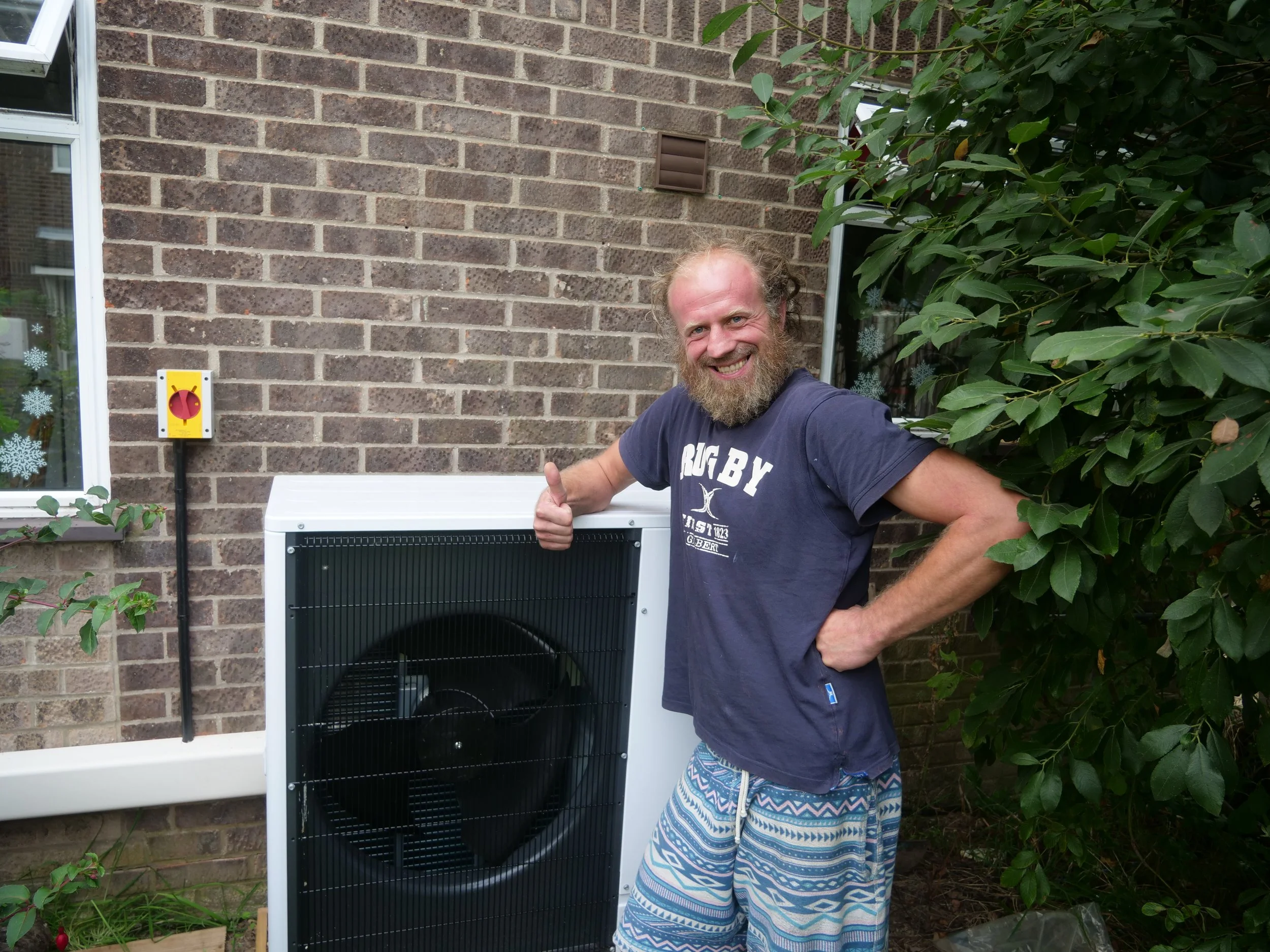Air source heat pumps
What is an air source heat pump? (ASHP)
An air source heat pump is an energy-efficient, low-carbon option to heat your home and generate hot water. It looks like an air conditioning unit and will vary in size depending on your property type, size, and requirements. Powered by electricity, it offers a more efficient alternative to traditional heating systems.
An air source heat pump works like a fridge in reverse. It takes in outside air to warm a refrigerant, which is placed under high pressure to increase the temperature. This heat is then transferred to water, which circulates through your home, just like a boiler-fired central heating system. It can heat both your radiators and hot water, which is stored in a hot water cylinder.
Download our air source heat pump explainer.
Is my home suitable?
To work efficiently, your home needs to be well insulated, otherwise heat will escape through walls or the roof. A surveyor will assess your property and calculate the space and heating needs. After the assessment, you’ll receive a detailed report outlining the system type, predicted annual running costs and a full plan for the new plumbing, water cylinder, radiators, and unit installation.
What is involved?
1. The heat pump: This is located on the outside of your property so there will need to be sufficient space for the external unit. The installer will identify the best place to position the unit and will consider airflow and distance from neighbouring properties to ensure everything meets regulations.
2. The internal heating system: This includes existing and new pipework which runs throughout your home to deliver hot water to radiators and taps. When the water cools, it returns to the heat pump to be reheated, completing the cycle.
3. The water tank: This stores hot water for everyday use. This can be put anywhere in your home but is typically placed in a cupboard and is usually larger than a traditional boiler’s hot water cylinder. The size of the cylinder will depend on the hot water requirements for your home.
Do I need to upgrade my radiators?
Radiator upgrades are important as they’ll improve the efficiency of your heat pump and reduce running costs. Heat pumps operate by sending water to radiators at lower temperatures compared to traditional boilers. As a result, you may need larger radiators to ensure your home stays warm. Larger radiators provide more surface area to distribute the heat effectively, ensuring your rooms reach the desired temperature even at lower water temperatures.
Why would I want one?
As an efficient form of heating it’s also a good way to do your bit for the environment. It could also lower your fuel bills, especially if you replace conventional electric heating.
What happens during install?
Installation typically takes 3 to 5 days and there will be disruption due to the need for plumbing, radiators upgrades, and the installation of the internal water cylinder and outside unit.
First, a solid base will be established, which may involve laying concrete blocks to ensure that the heat pump is level and secure. Inside, protective sheets will be laid to protect your home while the new hot water cylinder, pipework, and radiators are installed.
For a short period of time, an electrician will turn off your home’s electrics to safely set up the electrical components of the Heat Pump system. At some point during this process, your old heating system will need to be disconnected, but your installer will inform you in advance of any disruptions, ensuring the new system is up and running quickly to ensure you’re not without hot water for long.
The installer will also remove and properly dispose of the old heating system components you no longer need. Once the new system has been installed, the system will be checked by purging any air in radiators and checking the coolant levels in the heat pump. Finally, the installer will set up the heating controls to your requirements and provide a handover, demonstrating how the thermostat and setting controls work. We can confirm this at survey, but it normally takes less than a week, often only a couple of days.
Your installer will connect the external heat pump to the internal hot water cylinder using a control wire, a refrigerant hose, and a condensate drain hose. These will require a hole to be drilled through your wall.
Are they noisy?
Air source heat pumps do produce noise, but it is no louder than the hum of a traditional boiler flue.
What about maintenance?
Like gas boilers, it is recommended that air source heat pumps have regular maintenance, including an annual check. Typically, heat pumps last for 20 years and servicing should be done by an MCS accredited installer. You will also want to occasionally check for any leaves or rubbish that could get caught at the back, and side, of the heat pump and trim back any plants growing too close to the unit or its pipes. Your air source heat pump will continue to work in very cold weather (even at -15°C) but always make sure to clear snow off the pump if blocking air to the system. Always follow your installer’s instructions on how to use your heat pump.
Will I need to change my electric tariff & electricity meter?
Air source heat pumps run continuously, unlike traditional boilers. This means that if you previously had something like storage heaters with an Economy 7 tariff & meter, it is likely that you will want to change to something more suitable. We would encourage you to speak with your installer to ascertain advice about a suitable tariff.
What will it cost me?
If you are an owner-occupier or tenant and meet the grant criteria, then it will cost you absolutely nothing. The grant will cover the complete cost of the installation.
What will it cost to run?
Following a technical survey, the installer will use software to generate estimated running costs based on the specifications of the system and the heating needs of your home. You will be able to review these costs and decide whether the system is right for you. If you are replacing conventional electric heating such as old storage heaters then it should cost less to heat your home.
Do I need planning permission?
Usually, air source heat pumps do not require planning permission as they fall under ‘permitted development.’ However, if your home is in a conservation area, you’ll need to consult your local council’s planning team. Additionally, if you have taken out equity release or additional loan on your home (not mortgage), you may need approval from your provider before making improvements.
Where’s the catch?
There isn’t one. Any enquiry you make will be without obligation, you don’t have to have the work done until you are completely happy with the plan.
This programme is funded through the Department of Energy Security & Net Zero and administered on behalf of Norfolk Councils by Broadland and South Norfolk Councils.
All installation engineers are appropriately qualified to install heat pumps.
What do I do next?
You can call us on 01603 430103 to discuss this further or complete our enquiry form.
We will initially assess your eligibility and suitability of your property, then we will arrange for a home survey.
Air Source Heat Pump Case Study
Read about Mariusz’s Norfolk Warm Homes Journey here.
Still want to know more?
The Energy Saving Trust provides general advice and guidance: Air source heat pumps: costs, savings and benefits - Energy Saving Trust.




